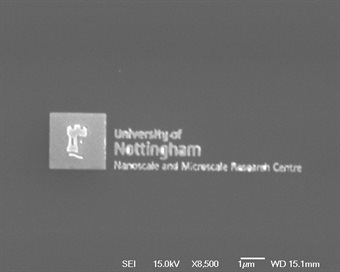Electron Beam Lithography
Electron Beam Lithography
The Nanobeam nB5 EBL instrument available at the nmRC
The Nanofabrication Nottingham (NaNo) cleanroom suite within the nmRC has been designed to perform high quality electron beam lithography (EBL) using a nanobeam nB5 EBL tool.
The nB5 is a state of the art EBL tool boasting features such as
- <10nm line width
- <20nm stitching and alignment
- 80KV accelerating voltage with beam currents from 0.5-15nA
- Holders for a range of substrates sizes including 5, 10, 15 and 25mm chips, a range of common glass cover slips and 2 or 3" wafers
- The ability to perform multiple exposures on a single run
The nB5 is located in a class 5 cleanroom equipped with all the equipment needed for EBL including: Spinner, hotplates, water bath and stirrers. In addition the cleanroom is being upgraded to contain a plasma cleaner, inspection microscope, coarse positioning stage and equipment for the fabrication of microfluidic devices. These will be installed by early spring 2019.
Electron beam lithography is a very powerful and versatile tool and has been used in work in numerous disciplines from: physics to chemistry to biology and electrical engineering. By combining it with tools such as thermal/e-beam evaporators and dry etchers it can be used to create features with dimensions as small as 10nm. We are able to perform EBL on a range of substrates including: Silicon, GaAs, GaN and glass.

Gold on silicon nmRC logo created using electron beam lithography and thermal evaporation. The smallest features have widths as small as 35nm.
Electron beam lithography works by using a beam of electrons to interact with a polymer based resist. We stock a range of resists that can be used for a number of different processess including the use of greyscale resists to make 3D structures.
Concave and convex structures created on silicon by using a greyscale resist
Unlike other electron beam lithography facilities we are keen to work with a range of more exotic materials. We plan to start working with bio-compatible materials and self-assembled monolayers in the near future. This will allow us to create devices for the bioscience research family such as methods to probe biological cells under a variety of environments and creating the conditions for the creation of synthetic cells.
If you think that EBL may help your research please contact Dr. Richard Cousins.